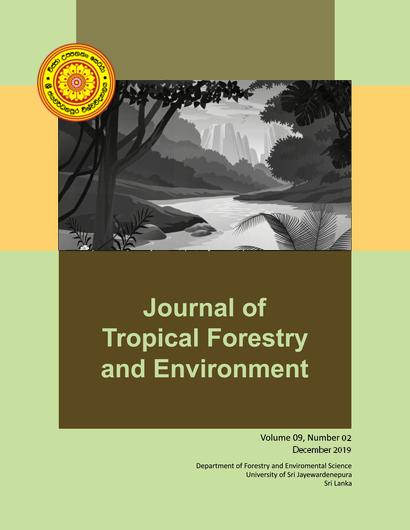Composition analysis of selected Sri Lankan seaweeds
DOI:
https://doi.org/10.31357/jtfe.v9i2.4471Abstract
Seaweeds are a rich source of health beneficial bioactive nutraceuticals and currently they are under-utilized in Sri Lanka. In the present study, proximate analysis of seaweed varieties Chnoospora minima and Porphyra sp. obtained from Mirissa, Matara, Sri Lanka and Ulva fasciata was taken from Point Dondra Matara, Sri Lanka on June, 2018 were investigated. The moisture content, total fat content, protein content and ash content were determined according to the Official methods of Analysis by Association of Official Analytical Chemists after drying for 8h at 600 C. The results revealed that the moisture contents (%) of Chnoospora minima, Porphyra sp. and Ulva fasciata were 13.24 ± 0.20, 14.30 ± 0.14 and 18.11 ± 0.01 respectively. Total fat contents (%) of Chnoospora minima, Porphyra sp. and Ulva fasciata were 0.21 ± 0.11, 0.19 ± 0.03 and 0.28 ± 0.05 respectively. Protein contents (%) of Chnoospora minima, Porphyra sp. and Ulva fasciata were 13.70 ± 0.2, 21.14 ± 0.04 and 11.84 ± 0.1. Total ash contents (%) of Chnoospora minima, Porphyra sp. and Ulva fasciata were 17.20 ± 0.24, 5.40 ± 0.7 and 18.05 ± 0.21 respectively. Total carbohydrate content (%) was analyzed according to the Dubois method. Chnoospora minima, Porphyra sp. and Ulva fasciata showed total carbohydrate content (%) as 3.87 + 0.66, 20.59 ± 0.24 and 7.68 ± 1.16 respectively. Moreover, the sulphate content was analyzed according to the precipitate method. Chnoospora minima, Porphyra sp. and Ulva fasciata showed 1.45 ± 0.35, 2.75 ± 0.07 and 4.54 ± 0.06, sulfate contents (%) respectively. In conclusion, highest ash content which indicates a good mineral content was observed in Ulva fasciata and Chnoospora minima. Fibre, protein and carbohydrate contents are significantly different among the 3 samples. Highest fibre content was observed in Chnoospora minima. Highest protein and carbohydrate contents were observed in Porphyra sp. But there is no significant difference in fat contents among the three samples.Downloads
Published
2019-12-11
How to Cite
Jayakody, M., Vanniarachchy, M., & Wijesekara, I. (2019). Composition analysis of selected Sri Lankan seaweeds. Journal of Tropical Forestry and Environment, 9(2). https://doi.org/10.31357/jtfe.v9i2.4471
Issue
Section
Articles
License
The publisher retain the copyrights of contents published, and all open access articles are distributed under the terms of the Creative Commons Attribution-Noncommercial-No Derivative Works 3.0 Unported License[U1], which permits unrestricted use, distribution and reproduction in any medium, provided that the original work is properly cited.
You can download the Legal Code for this License at: http://creativecommons.org/licenses/by-nc-nd/3.0/legalcode


